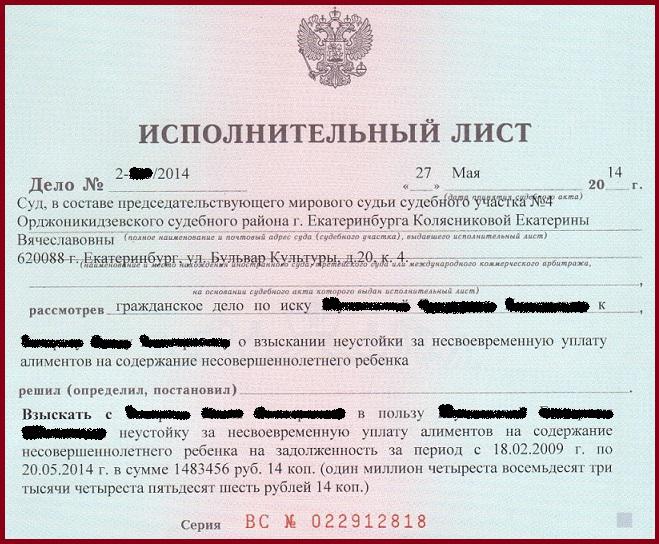A child support writ is a document for the enforcement of a court decision.
General idea of the document and its contents
A writ of alimony is issued exclusively by the court only after the deadlines for appealing against the decision made by the court expire and only in cases considered in the proceedings (that is, with the participation and hearing of both parties).
The document itself is a form that is strictly registered, and it just cannot be written out (only on the basis of an existing court decision).
A sample of a child support warrant is shown in the photo below.

If earlier the form of this document was more like a regular sheet of paper with the details and a solution manually prescribed, then at present it is a standard form in green tint, which has the necessary details and protection against possible fakes.
The content of the writ of maintenance obligations
The document consists of several sheets, protected by watermarks and the coat of arms of the Russian Federation.
The front page of the first sheet indicates: the name of the judicial authority that issued the decision, the number of the case and the date of its consideration, as well as the essence of the plaintiff's claims against the defendant with their details. The lower part prescribes the operative part of the decision, signed by the judge, and puts the official stamp.
The front page of the third sheet contains information about the debtor and the collector (last name, first name, middle name, year of birth and address), the date the decision entered into force and the date the sheet was issued.
On the penultimate page of the last sheet of the document, the corresponding marks of the services where the document was being executed are put.
All four sheets of the executive document are stitched and sealed with the signature of the secretary who prepared it and the official stamp of the court.
Like banknotes, each individual writ of execution has its own individual series and serial number. They are indicated on each sheet of the document.

The content of the operative part of the executive document on child support
In the recent past, the operative part of the decision and other details were entered manually by the secretaries, now the text is typed on a computer and printed on each sheet.
The decision itself in full cannot be transferred to the executive document, but only its operative part, which includes:
- The essence and subject of collection.
- With whom and in whose favor is a penalty imposed. As a claimant (recipient of alimony) may be:
- father or mother of the child;
- the official guardian of the child (for example, grandparents);
- state bodies (in the event that parents are deprived of their rights and the child is in the care of the state) in the person of orphanages and boarding schools;
- information on who the child support is collected (for example, in favor of a minor child or several children);
- in what amount the recovery will be made (depending on the number of minor children available to the defendant).
If alimony is collected for one or more children in a fixed amount, then the amount of this amount is prescribed.
- Deadline (until the child reaches the age of majority or until the death of the parent, if child support is collected in favor of the father or mother).
- Collection frequency (usually a monthly collection period).

Maturity Date of Alimony
As a rule, in the statement of claim, the plaintiff indicates whether the court should send a writ of execution for enforcement or hand it out.
The sheet received by the Federal Authority is subject to immediate execution.
On the contrary, a child support order, which is in the hands of the plaintiff, can be presented for sale at any time if there is no urgent need for immediate collection of payments.
Suppose a defendant pays support for a child (children) without a court decision, and this suits both parties, but at a certain point stops paying. In this case, the judicial alimony order you have in your hands can be presented for enforcement by the bailiffs at any time before the child (or the last child) is 18 years old, and for another 3 years after coming of age.

Features of the execution of the document
- The termination of payments under this document occurs only after the expiration of the period for which these payments are established, that is, when the child is 18 years old or the parents die.
- If the child’s father has never paid child support, then after the child reaches the age of majority, the child support order does not lose its strength.
- Exemption from payment of monetary support for their children is possible only by court order and if there are legal grounds.
- Enforcement proceedings may be completed without re-instituting proceedings only if the defendant regularly performed his maintenance duties for a specified period and in the absence of debts.
- The enforcement proceedings shall be terminated exclusively in the event of the death of the defendant, since obligations to pay alimony are not subject to inheritance either by law or by will.
Features of the calculation and determination of debt
The collection of alimony on the writ of enforcement by the bailiffs is carried out strictly in accordance with the amount of payments established by a court decision (in the amount of shares prescribed by law, or in a fixed amount).
Settlements can be made by the defendant both voluntarily and forcefully (by making deductions from the debtor's wages).
If the debtor evades periodic payments, the bailiff will calculate the debt for periods of non-payment. In this case, deduction of alimony on the writ of execution occurs:
- based on the size of the average Russian wage for the month in case the debtor does not have a permanent job or is employed informally;
- based on the cost of living in a particular region, if the court has established a fixed amount of alimony to be recovered;
- based on the total income of the defendant for the month, if the debtor has a permanent job, but refuses to pay child support.
When calculating the debt, the periods when the debtor made payments for maintenance on a voluntary basis upon presentation of confirming documents to the bailiff (for example, receipts or receipts of money transfers) are not included.

Since the amount of alimony collected in a fixed amount depends on the amount of the subsistence minimum stipulated for the maintenance of one child, the plaintiff has the right to apply to the court with an application for indexation of the collected alimony if the amount of payments falls below the minimum established by law.
Conclusion

It is important to understand that the accumulated and unpaid alimony debt for a certain period is to be collected in the general manner (as debt) after the child reaches the age of majority.